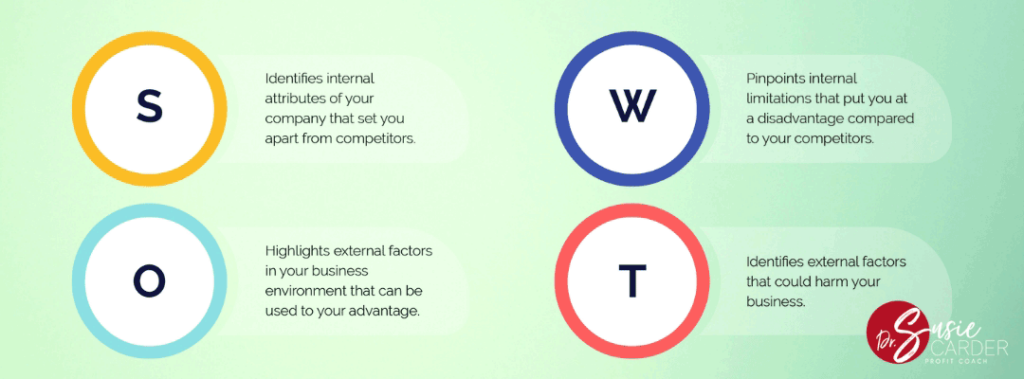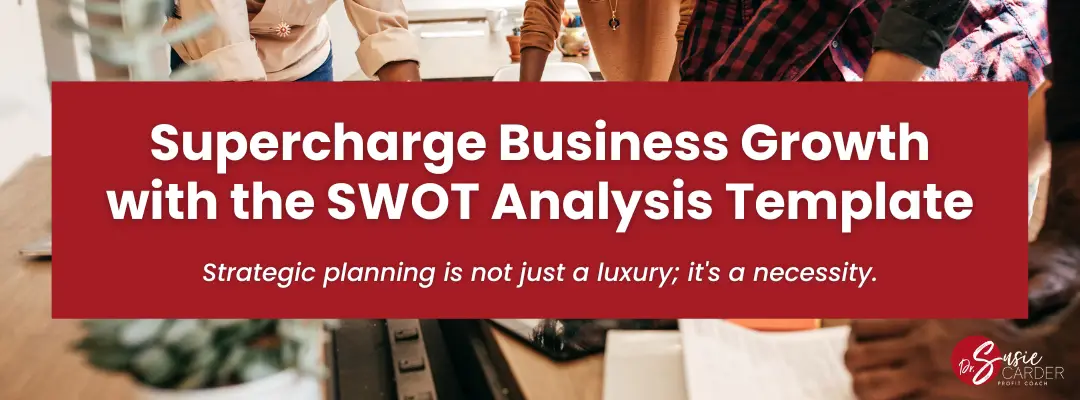Strategic planning is not just a luxury; it’s a necessity. Using a SWOT analysis template can help your business anticipate, adapt, and align your business strategy. In a world characterized by rapid changes and increasing competition, business strategy sets successful organizations apart.
SWOT Analysis provides a clear direction, fuels ambition, and serves as your north star in the corporate cosmos. SWOT is more than just an acronym, it’s a powerful tool that uncovers your Strengths, Weaknesses, Opportunities, and Threats. Utilizing this business tool equips you with the knowledge needed to navigate the intricacies of your business. Many of the world’s most successful companies, including Amazon, attribute their triumph to the effective use of SWOT analysis. It is a testament to its integral role in strategic planning.
A SWOT Analysis Template: Your Strategic Blueprint to Unleashed Potential

A SWOT Template is a structured tool that helps organizations identify and analyze their Strengths, Weaknesses, Opportunities, and Threats.
Strengths are the internal attributes of your company that set you apart from competitors. This may include robust financial performance, strong brand recognition, a skilled workforce, or superior technology. For example, Abercrombie & Kent, a renowned travel company, leverages its exceptional customer service and industry expertise to gain a competitive edge. Understanding your strengths enables you to fully utilize them and stay ahead of the game.
Weaknesses are internal factors that put you at a disadvantage compared to your competitors. A weak product offering, lack of innovation, poor customer relations, and high operating costs are examples of common weaknesses. Nokia’s failure to adapt to changing market trends. Acknowledging your weaknesses allows you to address them head-on, strengthen your position, and mitigate risks.
Opportunities, which are external factors in your business environment, can be used to your advantage. The rise of TikTok as a popular social media platform presents an opportunity to reach a younger audience. Additional opportunities in your business could be untapped markets, favorable government policies, technological advancements, or a competitor’s slip-up. Recognizing your opportunities can prompt strategic initiatives that capitalize on these favorable circumstances.
Threats are external factors that could harm your business. Stiff competition, changing consumer trends, unfavorable regulatory changes, and an economic downturn are examples of external threats. Kodak is a company that failed to adapt to the digital era and became obsolete. Identifying threats enables you to devise contingency plans, safeguard your business, and weather potential storms.
Remember, your SWOT Template is more than just a checklist. It’s a strategic blueprint that uncovers your potential, illuminates your path, and guides you toward sustained success.
Leveraging SWOT Analysis for Strategic Initiatives
Think of your SWOT Analysis as a strategic launchpad. It propels strategic initiatives, fosters innovation, enhances stakeholder engagement, and galvanizes your team toward shared objectives.
It enables informed decision-making, assists in risk management, promotes resource allocation efficiency, and paves the way for sustainable competitive advantage. Simply put, a SWOT Analysis is the key that unlocks your brand’s limitless potential.

Starbucks and Google are two global titans who have effectively leveraged the SWOT Analysis to dominate their industries.
- Starbucks identified its unique customer experience as a strength. They addressed their high price point as a weakness. They were able to exploit emerging markets as an opportunity. Finally, they prepared for the threat of local coffee shop competition.
- Google realized its strong brand reputation and innovative culture are strengths. They addressed its heavy reliance on advertising revenue as a weakness. An opportunity Google capitalized on is diversifying into new tech territories like AI. Finally, they accurately forecasted the threat of increasing competition in the digital space.
These real-world examples underscore the transformative power of a SWOT Analysis. Are you ready to bring your brand’s potential to light? Let the SWOT Analysis illuminate your path to unprecedented success.
How to Conduct a SWOT Analysis
Conducting a SWOT analysis is a systematic and reflective process. Here’s a step-by-step guide to maximize its potential:
- Identify Your Objectives: What do you hope to achieve? Is it expanding into a new market, launching a new product, increasing market share, or improving customer satisfaction?
- List Your Strengths: What unique competencies does your organization possess that give you an edge over your competitors? Is it a dedicated team, a strong brand, unique technology, or financial stability?
- Acknowledge Your Weaknesses: Are there areas where you lag behind? Is it a lack of innovation, high employee turnover, limited resources, or poor market reach?
- Explore Opportunities: What external factors can you capitalize on? Are there market trends, technological advancements, demographic shifts, or policy changes that you can leverage?
- Evaluate Threats: Are there any external forces that pose risks? Could it be economic downturns, aggressive competition, regulatory changes, or changing consumer behavior?
- Analyze and Act: Combine all your findings. Align your strengths and opportunities to your objectives. Formulate strategies to overcome your weaknesses and threats. Remember, the analysis is as good as the action that follows.
The SWOT Analysis is not a static document, but a living strategy that evolves with your business. Don’t just fill out the SWOT Template—activate it.
Using a SWOT Analysis Template is not about creating a comprehensive list, but about making strategic decisions to position your business for success. Use it as a springboard for strategy, a catalyst for change, and a roadmap for success. Are you ready to uncover your potential and propel your brand to a whole new level of success? Your SWOT journey begins now.
Crafting a Strategy Using the SWOT Template
Transforming your SWOT Analysis into an actionable strategy requires connecting the dots between your strengths, weaknesses, opportunities, and threats. This process is a strategic pivot that involves turning weaknesses into strengths, threats into opportunities, and above all, leveraging your distinctive strengths to seize opportunities.
Here’s a guide on how to maximize your SWOT analysis and drive meaningful outcomes for your organization:

Strategic Planning and Decision Making: Organizations need strategic planning and decision-making to navigate the business landscape. They can analyze strengths, weaknesses, opportunities, and threats. This analysis helps them create effective strategies. These strategies match goals with strengths and opportunities. Additionally, they aim to reduce weaknesses and threats for success.
Risk Management: Safeguarding organizations against threats and uncertainties is crucial. By identifying and assessing risks, organizations can develop contingency plans and strategies to mitigate them. This proactive approach minimizes negative impacts on operations and reputation.
Resource Allocation: Maximizing efficiency and productivity requires optimizing resource allocation. Organizations can achieve sustainable growth by using limited resources efficiently and focusing on areas with high potential.
Competitive Advantage: Gaining an edge over competitors is essential for market success. Strategic analysis helps identify and leverage unique strengths and opportunities. By developing strategies to differentiate and capture market share, organizations can outperform competitors.
Performance Improvement: Continuous improvement enhances performance and productivity. Strategic analysis identifies areas for improvement, providing a roadmap for enhancement. By setting achievable goals, organizations can drive continuous improvement and success.
Communication and Alignment: Effective communication and alignment ensure everyone is on the same page. Strategic analysis provides a clear overview, facilitating communication and alignment. With a common understanding, stakeholders can work together towards shared goals.
Innovation and Creativity: Staying ahead requires innovation and creativity. Strategic analysis identifies opportunities and inspires innovative thinking. By addressing weaknesses and threats creatively, organizations foster a culture of innovation.
Monitoring and Evaluation: Monitoring progress and evaluating strategies is crucial. Strategic analysis provides a baseline for ongoing evaluation. By tracking progress and adjusting approaches, organizations stay aligned with objectives.
Stakeholder Engagement: Engaging stakeholders is crucial for success. By incorporating their perspectives and insights, organizations benefit from diverse viewpoints and enhance collaboration. This approach fosters buy-in and ownership in the strategic direction.
Remember, the SWOT analysis and the subsequent strategies you derive from it are not just boxes to be checked off. They’re the stepping stones paving your path to success. You have the knowledge, the tools, and the power to turn your potential into unparalleled success.So what are you waiting for? Let the SWOT Template guide you on your strategic journey. The time for action is now!

Adapting the SWOT Analysis Over Time
In the ever-changing business landscape, your SWOT Analysis must be dynamic. It’s not a one-time exercise but a continuous process that requires consistent attention and fine-tuning.
As market trends shift, competitors emerge, or internal capabilities evolve, update your SWOT Template. Regularly reviewing and updating ensures it remains a valuable tool, reflecting your current business climate. Make it a part of your annual review, at minimum, but fast-paced industries may require more frequent updates.
Ask: Are the factors in your SWOT Analysis still relevant? If not, it’s time for an update.
Implement the SWOT Template in your strategic planning and witness its transformative power. Uncover strengths, address weaknesses, seize opportunities, and mitigate threats.
Remember, you’re not alone. Countless businesses have found success on this path, and so can you. Share your experiences, triumphs, and challenges. Inspire others with your story and continue this cycle of strategic success. Act now. Turn your potential into profit with the SWOT Template!






